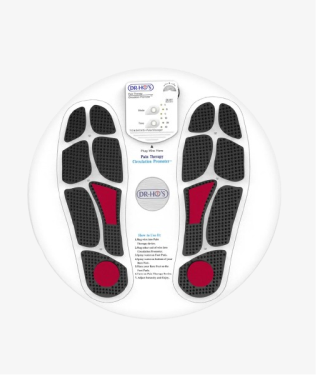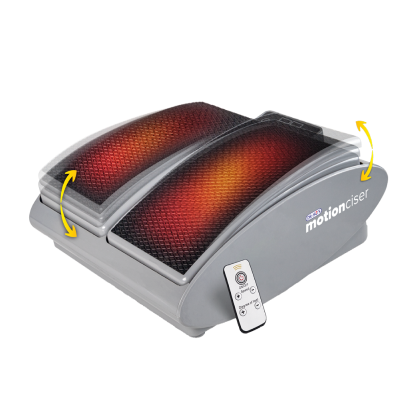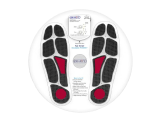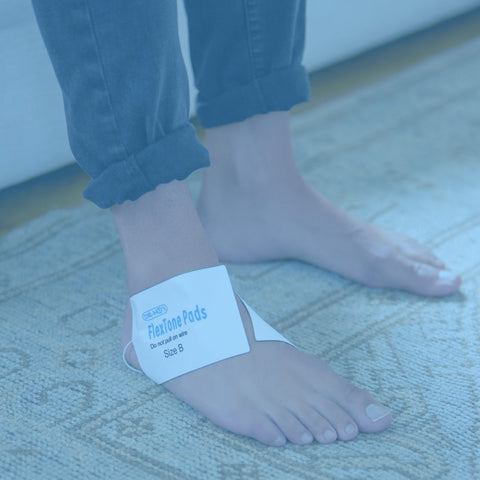Knee pain affects approximately 25% of adults, making it one of the most common sources of discomfort in daily life. If you've invested in a Transcutaneous Electrical Nerve Stimulation TENS device—a proven, drug-free approach that delivers gentle electrical impulses to help interrupt pain signals—you've already taken an important step toward managing your discomfort. Now, the key to maximizing your relief lies in one crucial factor: proper electrode placement.
Knowing exactly where and how to position your TENS pads can often make the difference between effective pain management and disappointing results. With the right placement techniques, you can more effectively target your specific type of knee pain and experience the full therapeutic potential of your device.
Understanding Your Knee: Anatomy Made Simple
Your knee is one of the body's most complex joints, where your thighbone (femur), shinbone (tibia), and kneecap (patella) come together in an intricate network of cartilage, ligaments, tendons, and muscles. This complexity means that knee pain can originate from various structures, and understanding the source of your discomfort helps determine the most effective electrode placement.
Common pain locations and what they typically indicate:
-
Front of the knee (anterior): Often related to kneecap issues like patellofemoral pain syndrome (runner's knee) or quadriceps tendon problems. This area is frequently affected by activities involving jumping, squatting, or prolonged sitting.
-
Back of the knee (posterior): May indicate issues with the hamstring tendons, Baker's cysts, or posterior cruciate ligament concerns. This type of pain often worsens with knee bending or prolonged standing.
-
Inner knee (medial): Often associated with medial collateral ligament stress, meniscus tears, or arthritis affecting the inner joint compartment. This pain frequently occurs with twisting movements or side-to-side activities.
-
Outer knee (lateral): Commonly linked to IT band syndrome, lateral collateral ligament issues, or lateral meniscus problems. Runners and cyclists frequently experience this type of discomfort.
TENS Pad Placement for Knee Pain: The Complete Guide
TENS therapy works by delivering electrical impulses through your skin to underlying nerve pathways. These impulses help interrupt pain signals traveling to your brain while encouraging your body to release natural pain-relieving compounds called endorphins. When electrodes are positioned correctly, they create an optimal pathway for these therapeutic signals, ensuring maximum coverage of the affected area while targeting the specific nerve pathways involved in your pain.
Primary placement method for general knee pain: The "sandwich" technique
For most types of knee pain, the most effective approach to delivering the desired pain relief involves positioning two large electrode pads on either side of your knee joint, essentially "sandwiching" the area where you're experiencing discomfort.

Step-by-step positioning:
-
Clean and prepare: Start with clean, dry skin around your knee area
-
Position the first pad: Place one large electrode pad on the inner (medial) side of your knee, approximately 2-3 inches above and below the joint line
-
Position the second pad: Place the corresponding large pad on the outer (lateral) side of your knee, mirroring the first pad's position
-
Maintain proper spacing: Ensure the pads are positioned so they don't touch each other, with at least one inch of space between them
-
Avoid the kneecap: Never place electrodes directly over the patella (kneecap) bone, as this can cause discomfort and reduce effectiveness
Why this technique works: The sandwich placement creates an electrical field that encompasses the entire knee joint, targeting multiple pain pathways simultaneously. This approach effectively addresses pain signals from various structures within the knee while providing comprehensive coverage of the joint area. The sandwich method will relieve knee pain for both acute knee pain (in response to injury), or chronic knee pain (another condition beyond injury response).
Condition-specific placement strategies
Different knee conditions may benefit from modified electrode positioning to target specific problem areas more effectively.
Patellofemoral pain syndrome (runner's knee)
For pain around or behind the kneecap:
-
Place one pad above the kneecap on the lower thigh
-
Position the second pad below the kneecap on the upper shin
-
Maintain vertical alignment while avoiding direct contact with the kneecap
This configuration targets the quadriceps and patellar tendon areas commonly involved in runner's knee while addressing pain signals from the patellofemoral joint.
IT band syndrome
For pain on the outer side of the knee:
-
Focus electrode placement along the lateral (outer) thigh and knee area
-
Place one pad on the outer thigh, approximately 4-6 inches above the knee
-
Position the second pad on the outer side of the knee, just below the joint line
-
This targets the iliotibial band insertion point and surrounding tissue
Meniscus-related pain
For joint line tenderness (inner or outer knee):
-
Use smaller electrode pads for more precise targeting
-
Place pads above and below the specific area of joint line tenderness
-
For medial meniscus issues: Focus on the inner knee joint line
-
For lateral meniscus problems: Concentrate on the outer joint line
Arthritis pain
For widespread knee discomfort typical of knee osteoarthritis:
-
Use the standard sandwich technique with large pads
-
Consider extending coverage slightly higher and lower to address the broader area of inflammation
-
Focus on consistent, gentle stimulation rather than high-intensity settings
Post-injury or post-surgery recovery
For rehabilitation and recovery support:
-
Use the sandwich technique but avoid any areas with surgical incisions or acute swelling
-
Start with lower intensity settings and shorter session durations
-
Always consult with your healthcare provider before using TENS therapy during recovery
Advanced placement strategies
Four-pad configuration
For complex or widespread knee pain, you may benefit from using four electrode pads:
-
Place two pads using the standard sandwich technique around the knee joint
-
Add two additional pads above and below the knee to extend coverage
-
This approach is particularly effective for pain that radiates from the knee into the thigh or calf areas
Combination treatment areas
Sometimes knee pain is part of a larger pattern of discomfort. Consider these combination approaches:
-
Knee + thigh: Address quadriceps tightness that may contribute to knee pain
-
Knee + calf: Target both the knee joint and supporting calf muscles
-
Knee + hip: Address biomechanical issues that affect the entire lower extremity chain
What Makes DR-HO'S Technology Superior for Knee Pain Relief
While proper electrode placement is crucial, the technology delivering the therapy makes an equally important difference in your results. DR-HO'S proprietary AMP Technology represents a significant advancement in pain relief devices, combining four therapeutic modalities in one innovative system.
Our AMP 4-in-1 technology advantage
Unlike traditional TENS units that deliver only one type of stimulation, DR-HO'S devices integrate:
-
TENS (Transcutaneous Electrical Nerve Stimulation): Delivers targeted electrical impulses that help interrupt pain signals traveling to your brain while encouraging the release of your body's natural pain-relieving endorphins.
-
EMS (Electrical Muscle Stimulation): Stimulates healthy muscle contractions that increase local blood circulation around your knee joint, delivering essential oxygen and nutrients to affected tissues while helping remove metabolic waste products that can contribute to pain and inflammation.
-
NMES (Neuromuscular Electrical Stimulation): Works to re-educate and strengthen the muscles supporting your knee joint, particularly important for long-term joint stability and pain prevention.
-
Auto-Modulating Pulses: This system continuously varies the electrical impulses, ensuring your body doesn't become accustomed to a single pattern. This helps ensure sustained effectiveness throughout your treatment and prevents the diminishing returns often experienced with conventional devices.
The science behind superior results
This integrated approach works with your body's natural healing processes in ways that single-mode devices simply cannot match. While TENS technology interrupts pain signals, EMS simultaneously increases circulation to promote healing. NMES helps maintain and strengthen the muscle support your knee joint needs for optimal function. The synchronized delivery of these therapies through our AMP Technology creates a synergistic effect that maximizes therapeutic benefit and provides more effective pain relief.
Clinical credibility you can trust
DR-HO'S devices are FDA-cleared and represent the only pain relief technology endorsed by the American Chiropractic Association. This recognition reflects our commitment to scientific rigor and clinical effectiveness, ensuring you're using a device designed with both safety and efficacy in mind.
Real-world advantage for knee pain
For knee pain specifically, this multi-modal approach addresses the complex nature of joint discomfort. Your knee pain often involves not just nerve signals, but also muscle weakness, poor circulation, and inflammatory processes. Our 4-in-1 technology addresses each of these components simultaneously, providing more comprehensive relief than devices that target only one aspect of your pain experience.
Important safety reminders and best practices
Your DR-HO'S TENS device is FDA-cleared and designed with your safety in mind. Like any health device, following some basic guidelines helps ensure you get the most benefit from your sessions. These common-sense precautions are simple to follow and help you use your device effectively:
-
Always start with your device turned off when placing or adjusting electrodes
-
Always use two pads of the same size to treat any area
-
Spray the pads with water before and after each use
-
In general, you never want the pads to touch
-
Begin with the lowest-intensity setting
-
Never remove electrodes while the device is running
-
Ensure electrodes are making good contact with clean, dry skin
-
Replace electrodes when they begin losing their adhesive quality
Areas to avoid
While your DR-HO'S device is designed to help provide relief, certain areas should always be avoided when placing electrodes:
-
Eyes or the surrounding area
-
Mouth
-
Front of the neck
-
Irritated or broken skin, or wounds
-
Any areas with tumors
-
Directly over the spinal column
Special considerations
-
Do not use while pregnant
-
If you have cardiac concerns, consult your healthcare provider before use
-
Do not use with a pacemaker or similar device
-
Always remove jewelry or metal objects from the area where you'll be placing electrodes
-
If pain persists, worsens, or is accompanied by other concerning symptoms (e.g., swelling, redness, fever, or numbness), consult a healthcare provider to identify and address the underlying cause.
Optimizing Your Treatment For Maximum Relief
Getting the most from your TENS machine involves more than just proper placement—it requires understanding how to fine-tune your treatment approach.
-
Start at the lowest setting and gradually increase
-
Aim for a strong but comfortable sensation—you should feel definite tingling without discomfort
-
Higher intensity doesn't necessarily mean better results; find your optimal comfort zone
Session timing for knee pain
-
Morning sessions: Many people experience knee stiffness upon waking. A 20-30 minute TENS session during your morning routine can help prepare your joints for daily activities.
-
Pre-activity treatment: Using your device 15-20 minutes before exercise or demanding activities can help reduce pain during movement.
-
Evening relief: End-of-day sessions help manage accumulated discomfort and can promote better sleep quality. Read more about how to relieve knee pain at night here.
-
As-needed relief: The portable nature of TENS therapy means you can seek relief whenever discomfort arises.
Complementary strategies
While TENS therapy provides effective relief for many people with knee pain, for optimal pain relief, it works best as part of a comprehensive approach to knee health.
-
Physical therapy: A qualified physical therapist can help identify muscle imbalances, movement patterns, or biomechanical issues contributing to your knee pain. They can design specific exercises to strengthen supporting muscles and improve joint function.
-
Lifestyle modifications:
-
Weight management to reduce joint stress
-
Activity modification to avoid aggravating movements
-
Proper footwear to support optimal lower extremity alignment
-
Ergonomic adjustments for work or daily activities
-
Exercise and strengthening: Focus on low-impact activities like swimming, cycling, or elliptical training that maintain joint mobility without excessive stress. Strengthening exercises for the quadriceps, hamstrings, and hip muscles provide crucial support for knee function.
Conclusion: Take control of your Knee Pain today
Proper TENS electrode placement transforms your device from a simple pain relief tool into a targeted therapeutic system that works with your body's natural healing mechanisms. By understanding your knee anatomy, using correct placement techniques, and optimizing your treatment approach, you can experience significant improvement in your daily comfort and mobility.
The key to success lies in starting with the fundamental sandwich placement technique, then adjusting based on your specific type of knee pain and individual response. Remember that TENS therapy is most effective when used consistently as part of a comprehensive approach to knee health that may include exercise, proper movement patterns, and professional guidance when needed.
With DR-HO'S advanced 4-in-1 AMP Technology, you're not just addressing pain symptoms—you're using a system that works with multiple therapeutic modalities to provide comprehensive relief. The combination of proper placement techniques with superior technology gives you the tools to take control of your knee pain and return to the activities you enjoy.
Start with the basic placement guidelines outlined in this guide, listen to your body's response, and don't hesitate to adjust your approach as you discover what works best for your unique situation. Quality relief is within reach—you now have the knowledge to achieve it.
Disclaimer: DR-HO'S content is intended for informational purposes only and should not be taken as medical advice. Please consult a certified medical professional for diagnosis and treatment recommendations.











